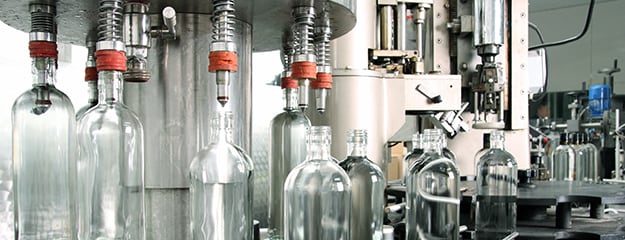Compressed Air in Beverage Packaging Plants: How to Ensure Purity

A properly designed air preparation and filtration system can go a long way to mitigate the risks of contamination within compressed air systems
It’s no surprise that product contamination during the filling and bottling of beverages is unacceptable to beverage packaging companies and manufacturers and, by extension, to the equipment OEMs that serve them.
What may be surprising to some packaging engineers, however, is how compressed air systems can contribute to this problem.
The compressed air that powers filling, bottling, capping and other packaging processes can emit moisture, oil, particles of dirt and microscopic bacteria, along with the air, if it’s not properly prepared. Fortunately, however, this utility can be treated and purified, reducing contaminants to acceptable levels and minimizing risk.
Here, we’ll discuss the contamination concerns and risks posed by compressed air: where they occur, how they’re minimized, and what it means for OEMs working to maximize productivity and performance in their pneumatic builds.
Multiple Sources of Contamination
The impurities in compressed air are numerous: Particles of dirt, oil, moisture, rust, pipe scale and microorganisms all can find their way into and through compressed air systems. These agents arise from three major sources:
1. Miniscule contaminants within the packaging facility’s ambient air can be drawn into the compressor’s air intake.
They include bacteria, particulate matter such as dust, and moisture in the form of water vapor.
2. Impurities can enter the system from the compression process itself. For example particles of lubricant, oil
aerosols and oil vapor are often generated during the compression process, and those can enter the stream
and taint products and packaging.
3. Rust and pipe scale from air storage tanks and distribution lines also can enter the compressed air, posing
a downstream risk.
Moisture in the form of water vapor, condensation and water aerosol, poses a risk throughout the compression system. After compression, the air is normally cooled with an aftercooler, condensing water for drainage but leaving humidity-saturated compressed air.
Later in the system, when pipes and tanks further cool this warm, saturated compressed air, additional condensation results. Liquid water corrodes the storage tank and distribution system, damaging valves, cylinders and other equipment. This water also can damage packaging in contact with the air, increase microbiological contamination, and promote the development of rust and pipe scale in lines. Over time the rust and pipe scale can break away, damaging or blocking production equipment and potentially contaminating the product.
Bacterial contamination is also particularly concerning. Lee Scott, market development manager with Parker Hannifin’s Industrial Gas Filtration and Generation Division, points out that in addition to moisture and particulate matter, inlet air to a compressor generally carries up to 50 bacteria per cfm. This translates to hundreds of thousands of bacteria per hour for a 75-hp compressor with a capacity of 300 scfm. These bacteria get compressed along with the air and make their way through the system. Because compressed air systems are warm, dark and contain moisture, they promote the growth of bacteria, allowing it to be released at exit points and put in contact with beverages, beverage packaging and surface areas.
Left untreated, compressed air with any of these impurities can contaminate the beverage product, resulting in a change of color or taste, reduced shelf life, product recalls and liability.
The Solution: Air Preparation
While the problems of contamination seem pervasive, the solutions are well-defined. Filters and treatment tools can counter-attack contaminants from each of the three sources noted above, not necessarily in order, but based on contaminant type and particle size.
As the first line of defense, bulk liquid separators staged after the aftercooler, storage tank or other cooling points in the distribution system will remove condensed liquids.
Next, particulate filters remove remaining condensed liquids as well as solid particle contaminants such as dust and dirt down to 5 micron. These are followed by coalescing filters, designed to remove water and oil aerosols (but not vapor), microbes and particulates down to 0.01 micron in size. Designed to be installed in pairs, particulate and coalescing filters ensure a continuous supply of high quality air.
At this point, water and oil in vapor form are stopped via refrigeration and desiccant dryers that lower the air’s dew point and dry the air for downstream applications.
For critical applications requiring the highest quality air, activated carbon filters may also be employed to remove airborne hydrocarbons and remaining oil vapors.
While coalescing filters may be used to remove bacteria at intermediate steps within the compressed air system, bacteria may also be present and pose a risk at the point of compressed air use, such as capping operations, for example.
Scott says point-of-use filtration of the compressed air, as defined by the ISO 8573 standard, is the best way to minimize bacterial risk where the compressed air comes in direct contact with beverages or packaging, as well as in non-contact areas that have a high risk of coming in contact with beverages or packaging materials. Point-of-use filtration, via three-stage point-of-use filtration modules, removes microbes down to 0.01 micron with a particulate removal efficiency rating equal to or better than 99.999 percent, per the ISO 8573 standard.
To maintain the quality of compressed air, facilities also need to employ specified filter maintenance schedules at each stage, along with periodic monitoring of compressed air at each contact point in accordance with ISO 8573 standards.
Benefits to Facilities
Beverage manufacturing companies and facilities with consistently clean, dry compressed air can expect to realize a number of cost and productivity benefits. For one, they are likely to experience longer life from pneumatic equipment, such as actuators, valves and cylinders, with fewer blockages, longer uptime and more consistent product quality.
The OEMs who serve these end users also stand to gain from this treatment strategy. They can expect smoother operations, a better partnership and long-term loyalty from their customers.



